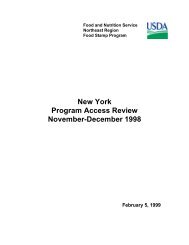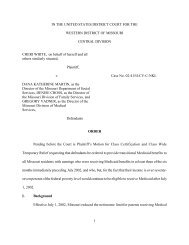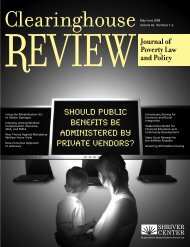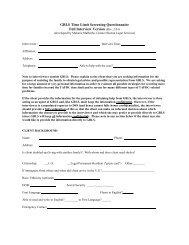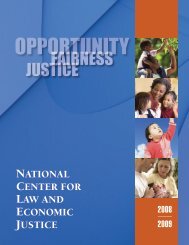The Role of the Courts in Securing Welfare Rights and ...
The Role of the Courts in Securing Welfare Rights and ...
The Role of the Courts in Securing Welfare Rights and ...
You also want an ePaper? Increase the reach of your titles
YUMPU automatically turns print PDFs into web optimized ePapers that Google loves.
<strong>Welfare</strong> Law Center<strong>the</strong> program. <strong>The</strong> application <strong>of</strong> <strong>the</strong> ADA to welfare programs, such as TANF, is largelyuntested, although some recent welfare cases have raised ADA claims.Overview <strong>of</strong> ADA<strong>The</strong> ADA is a federal civil rights statute that protects <strong>in</strong>dividuals with physical <strong>and</strong>mental disabilities aga<strong>in</strong>st discrim<strong>in</strong>ation <strong>in</strong> a range <strong>of</strong> public <strong>and</strong> private activities, <strong>in</strong>clud<strong>in</strong>gdiscrim<strong>in</strong>ation <strong>in</strong> programs <strong>of</strong> state <strong>and</strong> local governments (Title II), employment (Title I), publicaccommodations <strong>and</strong> services by private entities (Title III), <strong>and</strong> telecommunications (Title IV). 22An earlier federal law, § 504 <strong>of</strong> <strong>the</strong> Rehabilitation Act <strong>of</strong> 1973 is generally similar to Title II <strong>and</strong>III <strong>of</strong> <strong>the</strong> ADA. (<strong>The</strong> Rehabilitation Act covers federal agencies <strong>and</strong> federally f<strong>in</strong>anced programs.)Lawsuits <strong>of</strong>ten <strong>in</strong>clude both ADA <strong>and</strong> Rehabilitation Act claims. 23Title II <strong>of</strong> ADA is relevant for TANF programs, <strong>and</strong> <strong>the</strong> federal TANF statute makesclear that <strong>the</strong> ADA <strong>and</strong> Rehabilitation Act apply to TANF programs. 24Key features <strong>of</strong> Title II <strong>of</strong> ADA. Title II provides that “no qualified <strong>in</strong>dividual with adisability shall, by reason <strong>of</strong> such disability, be excluded from participation <strong>in</strong> or be denied <strong>the</strong>benefits <strong>of</strong> <strong>the</strong> services, programs or activities <strong>of</strong> a public entity, or be subjected to discrim<strong>in</strong>ationby any such entity.” 25 <strong>The</strong> ADA requires <strong>the</strong> covered entity (e.g. state <strong>and</strong> local governments <strong>in</strong><strong>the</strong> case <strong>of</strong> welfare programs) to make “reasonable accommodations” to assure mean<strong>in</strong>gful accessto programs <strong>and</strong> services. <strong>The</strong>re are extensive federal regulations <strong>and</strong> case law.To be protected under <strong>the</strong> ADA an <strong>in</strong>dividual must be a “qualified person with adisability.” This means <strong>the</strong> <strong>in</strong>dividual must meet <strong>the</strong> def<strong>in</strong>ition <strong>of</strong> disability, which is broaderthan <strong>the</strong> def<strong>in</strong>ition <strong>of</strong> disability for SSI <strong>and</strong> Title II disability purposes (<strong>the</strong>re is also an exclusionfor current illegal drug use). <strong>The</strong> <strong>in</strong>dividual must also meet <strong>the</strong> “essential eligibility requirements<strong>of</strong> <strong>the</strong> program” with or without reasonable modifications. <strong>The</strong> question <strong>of</strong> what is an essentialeligibility requirement is a likely area <strong>of</strong> dispute.May 1999⋅ 10 ⋅




